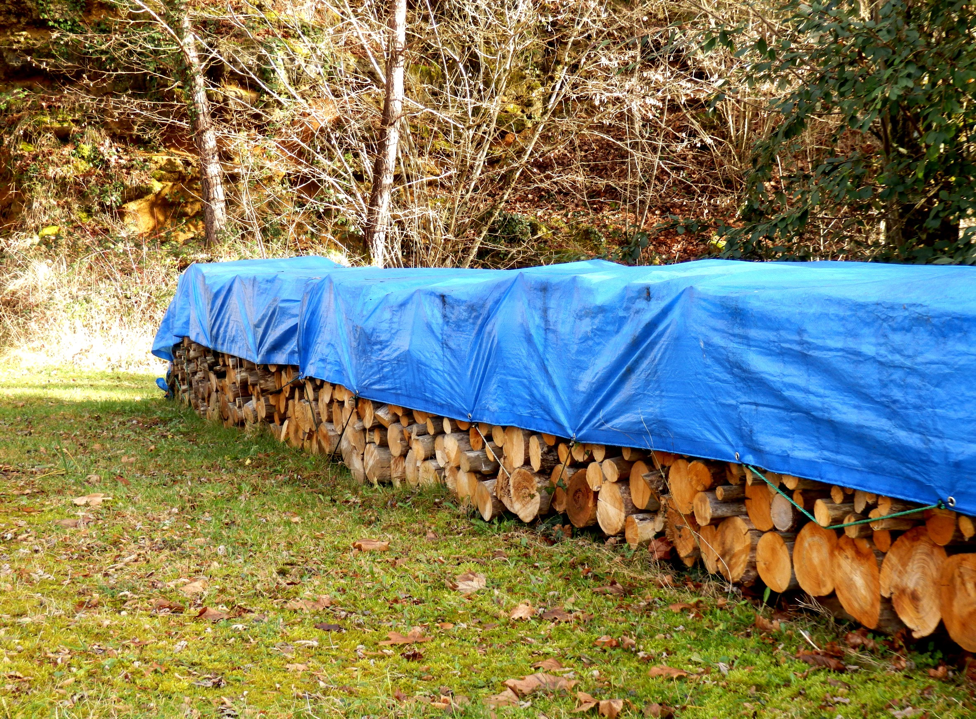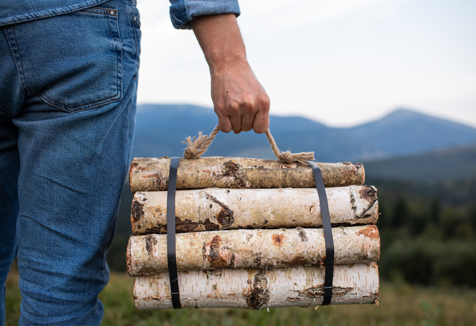How to Store and Season Firewood with a Tarp Cover
Posted by Canopies Tarps on Jan 19th 2020
How To Season and Store Firewood
Your dream of a chilly night in front of a cozy fireplace can become a nightmare if you discover all you have at your disposal is a useless pile of soggy logs. That's why a little pre-season planning is in order to have dry, seasoned wood at the ready for a welcome winter fire.

If you love summer campfires, fall barbecues and spring cookouts at the swimming pool, every season is when you'll want to follow these smart tips from the pros at Canopies and Tarps on how to season and store firewood for use any time of the year.
Wood Stacking
When building your woodpile, you want to find a location that is far enough away from the house that the woodpile won't create a path to the house for pests and critters, yet close enough that you can easily access the pile to collect firewood. Some store firewood in a woodshed or lean-to shelter; however, a simple stack can be sufficient.


Create a platform to raise your woodpile at least an inch or two from the ground or floor of a shed. There are commercial grates and racks available. You can create a DIY platform by laying out a few scrap 2 x 4 pieces or lining up pallets.
The base allows for air flow through the woodpile. It also makes the pile less susceptible to rot and insect infestations.
Once the base is secure, you can start building your woodpile.
Start with larger pieces of wood to create a sturdy base that will keep the pile secure. You can alternate layers with smaller pieces, mixing kindling-size wood with more substantial logs. Another strategy is to alternate the direction of smallest, or cheapest firewood purchased with largest pieces, positioning alternate layers perpendicular to the previous layer.
Season for the Season

If you gather your own wood instead of buying it, the gathering of firewood is never done. You work through warmer months to cut trees down, chop trunks and branches into smaller pieces and split wood into even smaller sizes ready for burning.
Even then, the wood is not ready for the fireplace. Wood needs to cure for at least a year, although some experts recommend up to two or three years to fully season the logs. This essentially means that you give it time to dry, which allows the wood lose all its moisture.
If wood still has moisture - or even worse, if it's wet when you put it on the fire - it will create unwelcome smoke and burn much faster. You'll get longer burning time and more even heat if you let your wood cure for a few seasons before use.
Firewood Cover Ideas
Whether a woodpile is being seasoned or it's ready to burn, it's important to cover it, especially during foggy, rainy and snowy months.
Because the goal is to dry your wood, guarding against precipitation is the main reason to cover your woodpile. There are commercial covers available from respected companies like Canopies and Tarps, as well as storage sheds.
The easiest, least expensive solution is to cover your wood with a heavy-duty tarp. These waterproof tarpaulins with grommets for easy tie-downs covers are built to protect against the elements.
Firewood Tarps
Find a tarp that is larger than the top of your woodpile, or fold the tarp to size. You want the tarp to hang over about a few inches but not much more. The idea is to cover the top to shield against rainfall and snow accumulation. However, you want to keep the sides of the pile exposed to promote air flow through the stack.
While a tarp can be the perfect woodpile covering, it needs a little help to stay in place. You can weigh it down with bricks, or even string bricks together to drape over the tarp.
The tarp's grommets are ideal for tie-downs. You can use bungee-style tie downs, or use twine and stakes to hold the tarp in place during rain, high winds and other inclement weather.
Covering firewood with tarp is also good for seasoning wood, if you keep the wood loosely covered to keep the air flowing through the wood to prevent accumulation of moisture. Sunlight remains the best drying agent, so never cover your firewood from top to bottom.
Some prefer the breathability of 100% cotton natural canvas tarps to loosely cover firewood stacks, especially while they are being seasoned, or "cured." They are water-resistant, but not waterproof like poly tarps. To speed drying, you can also remove the bark before placing logs on your woodpile.

Remember to secure the tarp in a way that allows for easy access to the pile for the wood you plan to use all winter - or throughout the year.
With your woodpile set and secured with a tarp, you will soon be ready to settle into a comfortable seat next to the fire - whether it's at a backyard firepit or at your home's fireplace - and appreciate all that work and preparation.
Here's another handy tarp tip from Canopies and Tarps. Keep a small tarp and several inexpensive bungee cords on hand to wrap, secure and transport small bundles of firewood from your fire log stack to your house, backyard firepit or weekend campsite.


